
Based on “TCP at 40: Celebrating the Conception of Internet Protocols,” by Marc Weber, which appeared in the July-September 2014 IEEE Annals of the History of Computing. ©2014 IEEE
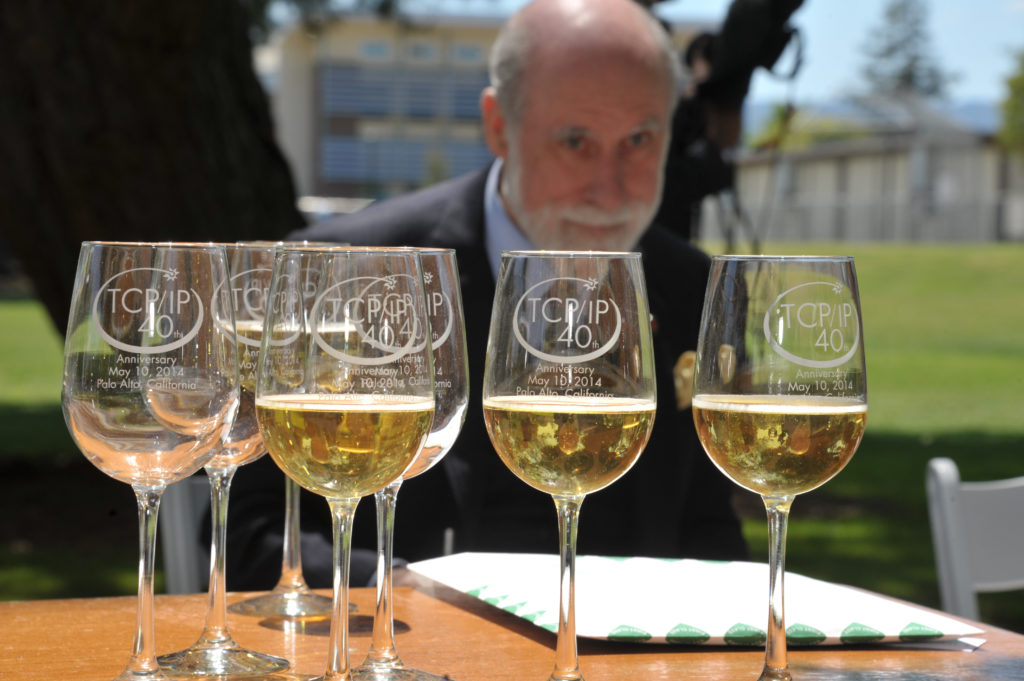
Commemorative glasses, Vint Cerf behind. Copyright Douglass Schwartz
This past 10 May 2014 marked 40 years since Vint Cerf and Bob Kahn published a paper hammering out the rudiments of the standard that would become known as “the” Internet: TCP, or Transport Control Protocol, later expanded to TCP/IP. The two ARPAnet alums had done the main work in a frenzied two-day burst while holed up in a Palo Alto hotel room the previous September. Theirs wasn’t the first standard for the process of tying networks together, known as internetting. It didn’t even become a major contender until the late 1980s. But the TCP standard that came out of that hotel room would beat out a number of rivals to become the basic design of today’s Internet, which provides the “plumbing” for familiar applications like email, the World Wide Web, and smartphone apps. Today the Internet connects nearly half the world.
To celebrate the anniversary, more than 100 people—including networking pioneers of several generations—gathered for a picnic on a bright, windy Saturday afternoon in Palo Alto’s Mitchell Park. The site is about a mile from the Cabaña Hyatt (now Crowne Plaza Cabaña) hotel where Cerf and Kahn did their work.
The shallow outdoor amphitheater was filled with white folding chairs, and attendees were given box lunches as they arrived. Around the edges were tables with show and tell items including a scale model of the van in which Internet protocols were first fully tested over multiple networks in 1976 and 1977.
Mei Lin Fung, one of the main organizers along with Bill Daul, welcomed everybody. MC John Feland of Stanford’s ME310 Innovation Center introduced Vint Cerf, who described some of the events of September 1973 as he and Bob Kahn filled pad after pad with scribbled notes. He was followed by recollections from two of his former students: networking pioneer Yogen Dalal, a coauthor of the first detailed TCP specification as well as an architect of the competing PUP (PARC Universal Packet) protocol, and Judy Estrin. Estrin was part of the original group that worked on TCP with Cerf, and she went on to found or head a number of key networking companies.
Dan Lynch, whose 1980s Interop Conference was a kind of neutral arena for the viciously competing networking standards of that era to go toe-to-toe in live demos, described his very early experiences working on TCP.
John Shoch then gave the perspective on internetworking from the Xerox PARC side. As an outgrowth of Ethernet, PARC had internetworking actually up and running on a demo router by 1973 using its own PUP protocol. But company policy kept the PUP details an internal secret.
Shoch was a major contributor to the later stages of PUP as well as the author of the first computer worm, inspired by the science fiction novel The Shockwave Rider. He is a long time trustee of the Computer History Museum.
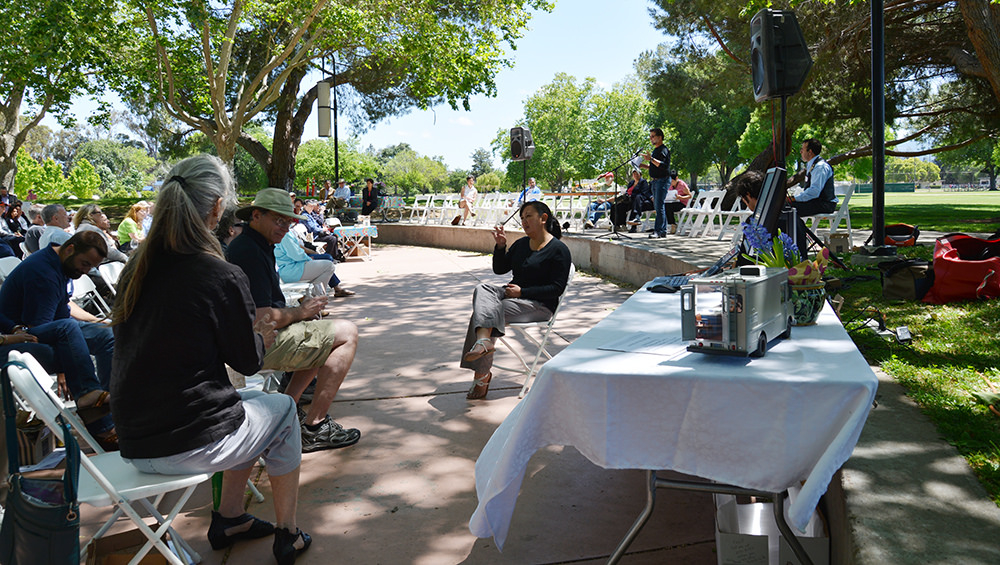
The model SRI Packet Radio van in the foreground is a smaller version of the one on display at the Computer History Museum, which preserves the original van. Copyright Bill Daul
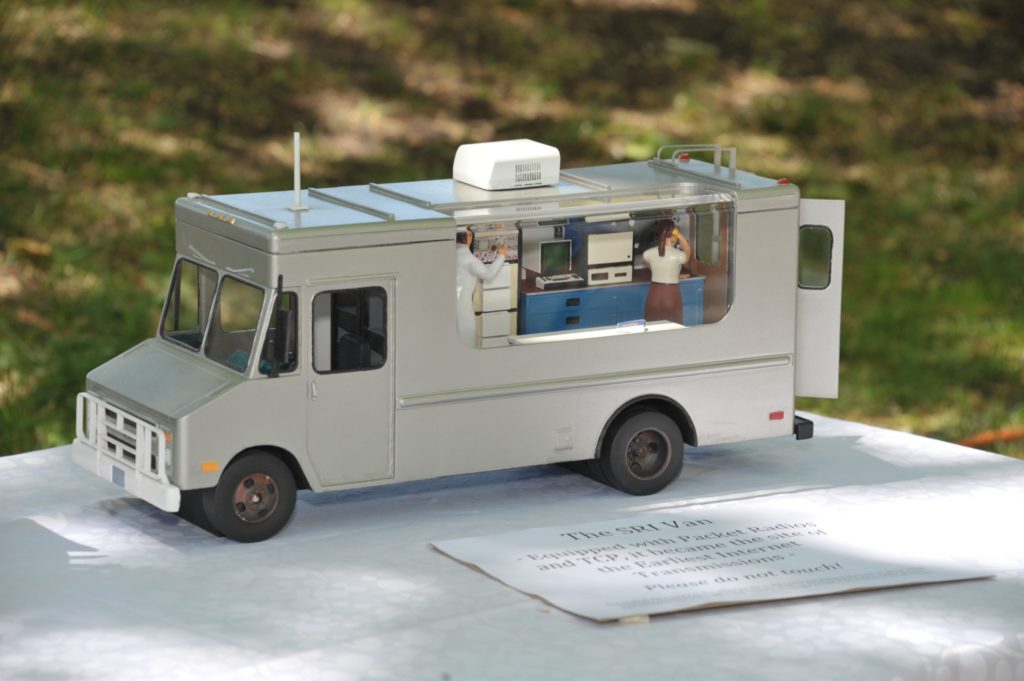
Closeup of SRI Packet Radio van model. Copyright Douglass Schwartz
Also speaking were Charles Goldfarb, a main inventor of markup languages like HTML, and Sean Askay of Google. Askay heads Tour Builder for Google Earth, a new tool the anniversary event organizers had used to construct a virtual tour of key sites.
I spoke about the meaning of the event from the perspective of the Computer History Museum and its Internet History Program, which I head, and how I’ve come to see anniversaries after nearly 20 years of studying the history of the Web and networking. The below is based on what I said.
The way a lot of us were taught at school, invention is kind of like a lightning strike. A lone genius comes up with something new, whether it’s the light bulb or relativity, and Eureka! the world is changed. As we got older we may have heard of parallel invention – the way the same idea seems to crop up around the same time in different places. Telegraphs got invented several times in the 1830s. A few decades later Elisha Gray and Alexander Graham Bell filed patents for a telephone within weeks of each other. Marconi and Tesla both helped pioneer radio. And so on.
In creating the Computer History Museum’s permanent exhibition on the history of computing, my colleagues and I saw this kind of clumped inspiration again and again. The lone inventor is actually the exception. The digital computer’s birth, for example, was surrounded by so many competing claims we have a movie about it (Who Invented the Computer?). The Networking and Web galleries are organized around clusters of competing systems, with one main winner emerging victorious from each battlefield (local networks, global networks, Web-like systems). We realized that this was the norm, across a variety of domains.
Mini-movie “Who Invented the Computer?” from CHM’s Revolution exhibition
So from the steam engine to the Web, most everything has been independently conceived at least three times. But more than that, we saw that major inventions often go through pretty much the same stages on their way to success.
Given all these parallel tracks, how should we think about inventions? What should we celebrate, and why?
First I’ll talk a little bit about those stages. Like a child, most inventions have a moment of conception, and one of birth.
On the 40th anniversary of TCP, we’re celebrating the conception of Internet protocols, the light bulb moment when the raw ideas first came together in a concrete form. This is parallel to another big anniversary of 2014, 25 years since the first proposal for what became the World Wide Web.
But while 1973 was the year of conception for TCP, similar efforts around the world were already well underway. A number of researchers had arrived at similar solutions to a common problem: how to get incompatible computer networks to talk to each other.
By the early 1970s, the practice of connecting once stand-alone computers together into general-purpose networks was barely five years old. But already there were more than half a dozen such networks: ARPAnet, England’s NPL Mark I, France’s CYCLADES, and so on. ARPA itself was in the process of commissioning two more, the Packet Radio Network and the Satellite Network.
Yet while they successfully joined once-isolated computers – and the communities which shared them – none of these networks could talk to each other! What was needed was way to create a network of networks, a process known as “internetworking” or “internetting.”

The European Informatics Network demonstrated internetworking between England’s NPL network and France’s CYCLADES network, with nodes in Italy and Switzerland. Copyright NATO Advanced Studies Institute
So the same year that Cerf and Kahn were holed up in their hotel room, the European Informatics Network was experimentally connecting the NPL Mark I network in the UK with CYCLADES in France, using internetting techniques pioneered by the CYCLADES researchers. Behind closed doors, Xerox’s PARC research center was hooking up Ethernet to other local area networks that same year with its new PUP protocol for building networks of networks, or “internetting” as it was known at the time.
Both these efforts would influence the shape of TCP. In fact, it would soon lengthen its full name to the tongue-twisting TCP/IP (Transport Control Protocol/Internet Protocol), to reflect new support for the kinds of internetting protocols used in CYCLADES.
The next big moment in the TCP arc – we can term it the birth – came in 1977. That’s when a number of institutions collaborated on the first test of the new protocol across three of ARPA’s networks: the original ARPAnet, the Packet Radio Network (PRNET), and the Satellite Network (SATNET). These successful tests were orchestrated from the SRI Packet Radio Research Van as it was being driven around the San Francisco Bay Area. While rolling, it sent packets to Norway, England, and back again with no errors.
In 2007 Don Nielson of SRI and I organized the 30th anniversary of that event at the Computer History Museum with Vint Cerf, Bob Kahn, Irwin Jacobs of SATNET and Qualcomm, and a dozen or so representatives from the different participants in both the US and Europe. The original van is part of the Museum’s collection.
In the late 1970s, Xerox was using its PUP protocol to create an in-house internet of its own, connecting a few hundred of its Alto machines at different sites across North America.

Commemorative button. In 1983 computers running the old ARPAnet NCP protocol were upgraded to TCP. Credit: https://blogs.diariosur.es/informaticauma/
The third big milestone has no obvious biological equivalent, except perhaps baby birds being kicked out of the nest. This was the actual deployment of TCP across the ARPANET and other government networks in 1983. Some earlier competitors, like CYCLADES and PUP, had no equivalent moment because they never truly spread.
For the Web, the parallel moment might be the 1991 public release of the WWW code library over the Internet. This was the “build your own browser” toolkit that gave a number of would-be browser makers – including the authors of Mosaic – the basics they needed to put together their own Web browsers and servers.
All these milestones – conception, birth, deployment – deserve their own kind of recognition.
But parallel invention also makes us think about invention itself. Because the fact that inventions are multiple brings up the zillion dollar question: why some prevail, and others not. Why do we use the Web and not Gopher? Why did TCP and not OSI, or PUP, or SNA, or CYCLADES, or Transpac become the basic transport mechanism for everything from Web pages, to movies, to newspaper and emails and tweets and the images on baby monitors?
Part of the answer is of course chance. Because there are so many parallel tracks, parallel inventions, it doesn’t always take a lot to switch from one to another.
Had the administration in France not changed at a particular moment in the late 1970s and cut funding for Louis Pouzin’s CYCLADES network, the history of both TCP and the official favorite OSI (Open Systems Interconnect) might have been very different.
Had the Web not become public domain the same spring that its rival Gopher started charging for servers, we might have our sites administered by GopherMasters today.
So if invention is multiple, why do we celebrate only the winners? The answer is that if we do our celebrating right, we actually do honor the losers – by remembering them, as I am here. Milestones are a chance to celebrate not only the victor, but the noble opponents, the also-rans that were absorbed into the victor or came close to claiming the prize themselves. It’s OK to anchor anniversaries around events in the victor’s story, because public events have to make sense to the public. If we announced the 25th anniversary of Gopher’s start, few would understand. But we can honor Gopher on a Web anniversary.
So why did TCP succeed?
An obvious factor in its early progress is that ARPA’s efforts were a lot bigger and better funded than, say, the NPL Mark I network in England, or Louis Pouzin’s CYCLADES team in France.
Then there was aggressive strategy – like ARPA forcing the authors of the widely-used Berkeley UNIX operating system to build in support for TCP – and luck, like Cisco including support in their line of popular routers. More luck came from the a young senator named Al Gore, whose support would put nearly a billion dollars behind the nascent standard, mostly to connect centers of higher education.
Without such “facts on the ground,” it’s doubtful that ARPA’s scrappy David could have beaten well-backed Goliaths like OSI, the official favorite of governments and standards organizations, or hugely installed proprietary standards from DEC or, especially, IBM.
There were also internal factors behind TCP’s eventual triumph.
First, there was the fact that unlike CYCLADES or NPL or even PUP, ARPA as an institution had funded a number of incompatible networks, and thus had a very practical need to connect them together.
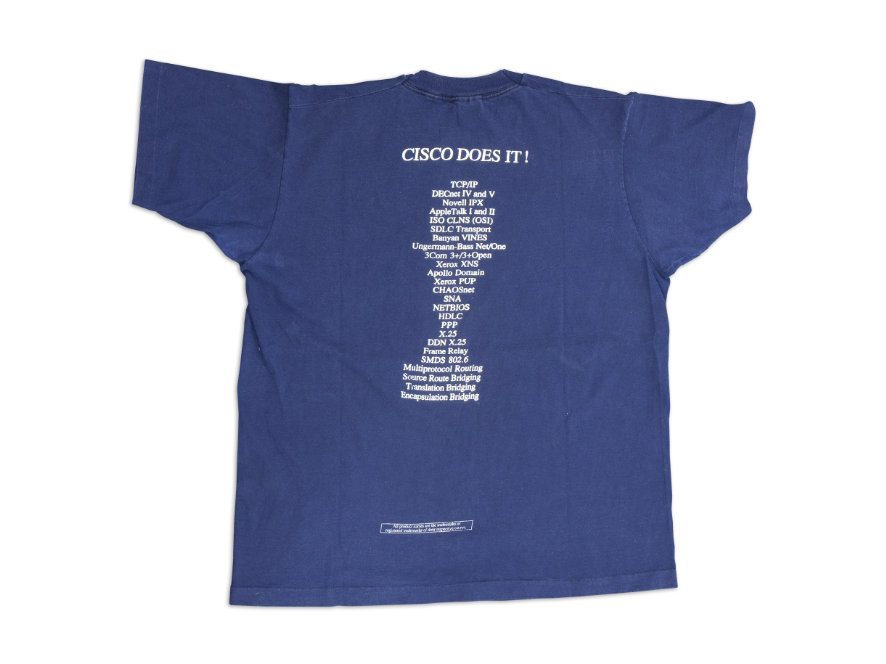
Cisco built its business on routers that could translate between many protocols, as this T-shirt shows. TCP support came early on. Copyright Mark Richards
The second reason was a matter of culture, and collaboration. While much has been romanticized, there’s no doubt that the kind of freewheeling, meritocratic, hackerish, open source culture which coalesced around the ARPAnet and then the Internet played a real role in their success. Both Vint Cerf and Bob Kahn spent the formative parts of their careers in that world of early RFC’s and open collaboration, whose values Dave Clark famously characterized as “rough consensus and running code.”
Programmers within CYCLADES or the English NPL could have fit into the same culture, but there weren’t enough of them bunched together to reach the same critical mass. PARC was in fact a part of the same culture, but its researchers’ urges to collaborate were limited by corporate needs and policy.
This Internet culture later had a very direct influence on the Web.
Ben Segal is the guy who brought the Internet to CERN, where the Web was born, and was one of Tim Berners-Lee’s key mentors. He said the Internet came to Europe “culturally bundled” with a number of other things; not just UNIX and some emerging hardware like Cisco routers but also a particular attitude and way of working. Ben was also the person who got me interested in the Web’s history in 1995.
Tim Berners-Lee became a huge admirer of the Internet and its ethos. While technically the Web could run over other networks, it was forged within that culture of open standards and collaboration, working groups and Birds of a Feather meetings and more.
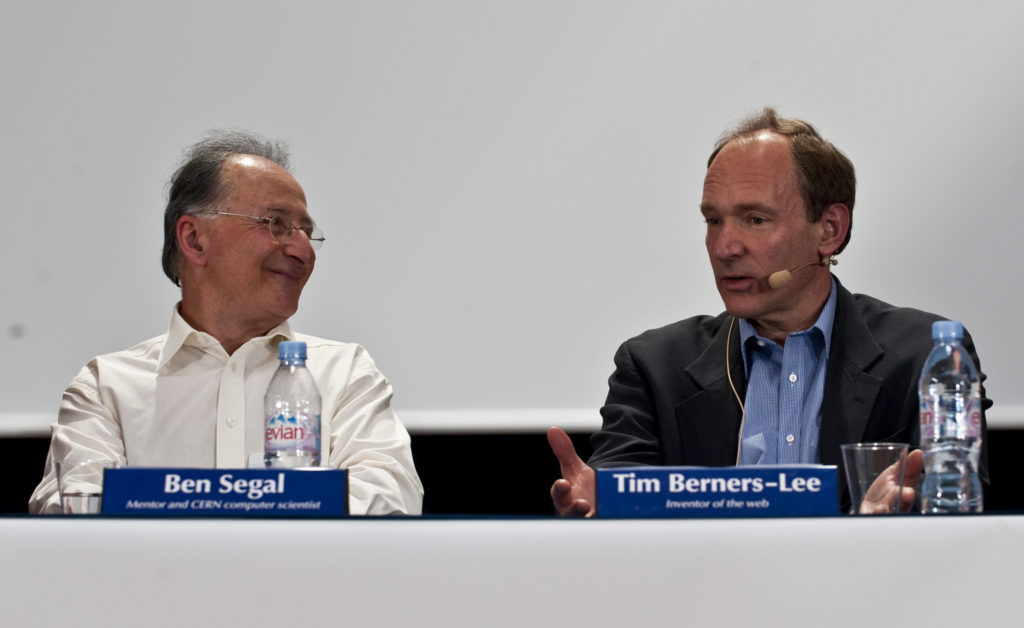
Ben Segal (left, with Tim Berners-Lee) brought the Internet to the Web’s birthplace, CERN. Courtesy CERN.
This would give the Web its particular niche.
In the late 1980s the Internet was quietly winning over other standards, even if not everybody realized it at the time; as late as 1989 many insiders still felt that OSI was the ultimate future of internetting.
But that left a vacuum at the top. The Internet was an explicitly non-commercial network, and none of the owners of established online systems for navigating information were going to put any effort into adapting their products to run over it; not Minitel, or CompuServe, or any of polished user-oriented systems of the era.
The result? The only people trying to provide easy-to-use online systems for the Internet were small projects like Brewster Kahle’s WAIS, and Pei Wei’s Viola, and Gopher, and Lynx, and Berners-Lee’s World Wide Web. Rather than closed walled gardens, these systems were mostly built in the open and collaborative spirit of the internet community.
An indicator of that spirit is that when the Web began to get real traction, several of the others dropped their own projects and turned them into early Web browsers.
Today, the Web and Internet serve over three billion people. But that means they’re only halfway there; the next chapter will be as they become truly world-wide and connect the other half of humanity.
*
As the talks moved into the second hour, co-inventor of public key cryptography Whitfield Diffie noticed that Vint Cerf was sitting bare-headed in full sun. He came up behind and offered his wide-brim safari-style hat, which provided welcome relief and a visual contrast to Cerf’s trademark three-piece suit.
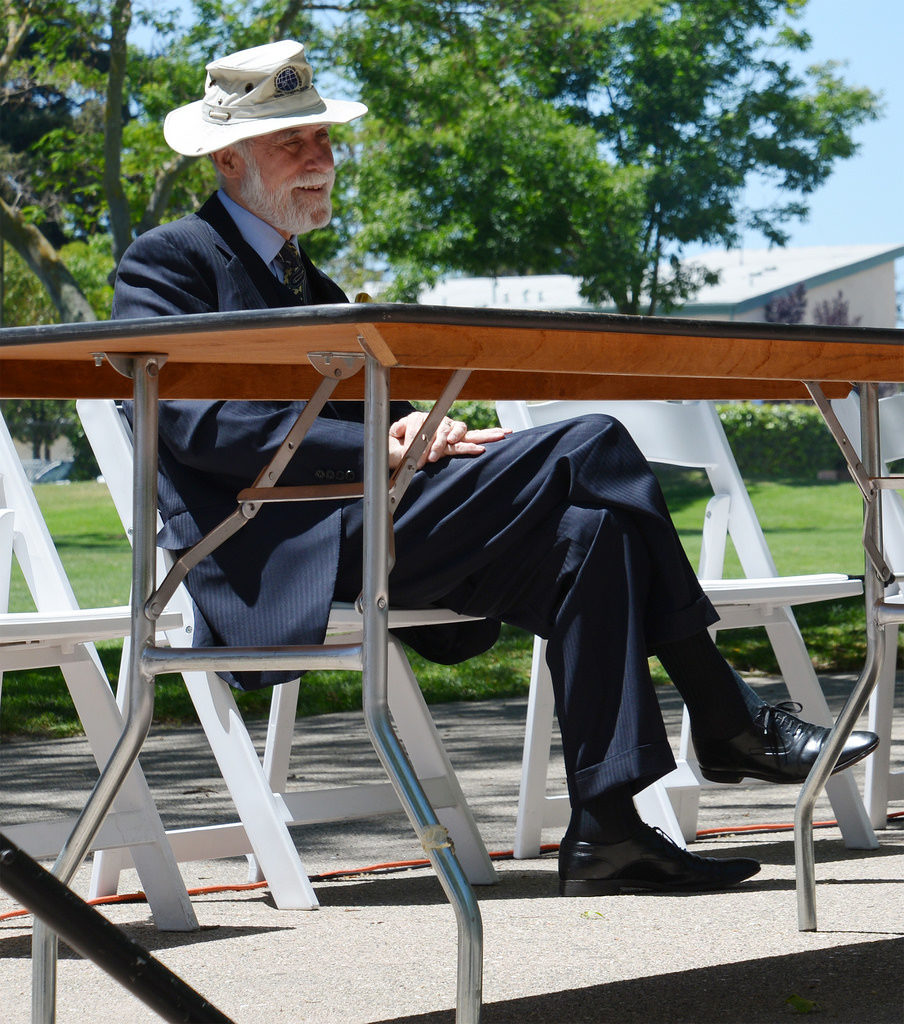
Vint Cerf wearing Whitfield Diffie’s hat. Copyright Bill Daul
The formal speeches ended with a ceremonial toast of sparkling apple juice in commemorative glasses (see Figure 2), a cake, and a plaque presented by the mayor of Palo Alto. The plaque was later installed at the Crowne Plaza Cabaña hotel.
MC John Feland gave a number of others the opportunity to speak in an open mic session, including packet radio and Internet pioneer Don Nielson, retired vice president of SRI; former head of the SRI Network Information Center Elizabeth “Jake” Feinler; and a number of computing and networking pioneers from Danny Cohen and Steve Casner to Les Earnest to Dave Crocker.
Among the last open mic speakers were two I was very happy to be able to invite to the event, and who made the fact of parallel invention – and chance – feel very real indeed. These were Olga Kitova, daughter of Soviet computing giant Viktor Glushkov, and her husband Vladimir, the son of networking visionary Anatoly Kitov. In the early 1960s his father had proposed a dual-use military and civilian computer network to link all of the Soviet Union, for coordinating not only production and military responses but to share information widely. Kruschev and the Party leadership embraced the control aspects but were cautious about the sharing part. Glushkov, who knew of Kitov’s ideas, later fought hard for an even more far-reaching computer network for economic planning, one that he hoped would replace money itself. While the Soviet Union would develop several key early networks, none had the broad scope of the proposals from Kitov and Glushkov.
Had the politics played out another way we might be celebrating somewhat different anniversaries, and in Russia or Ukraine.
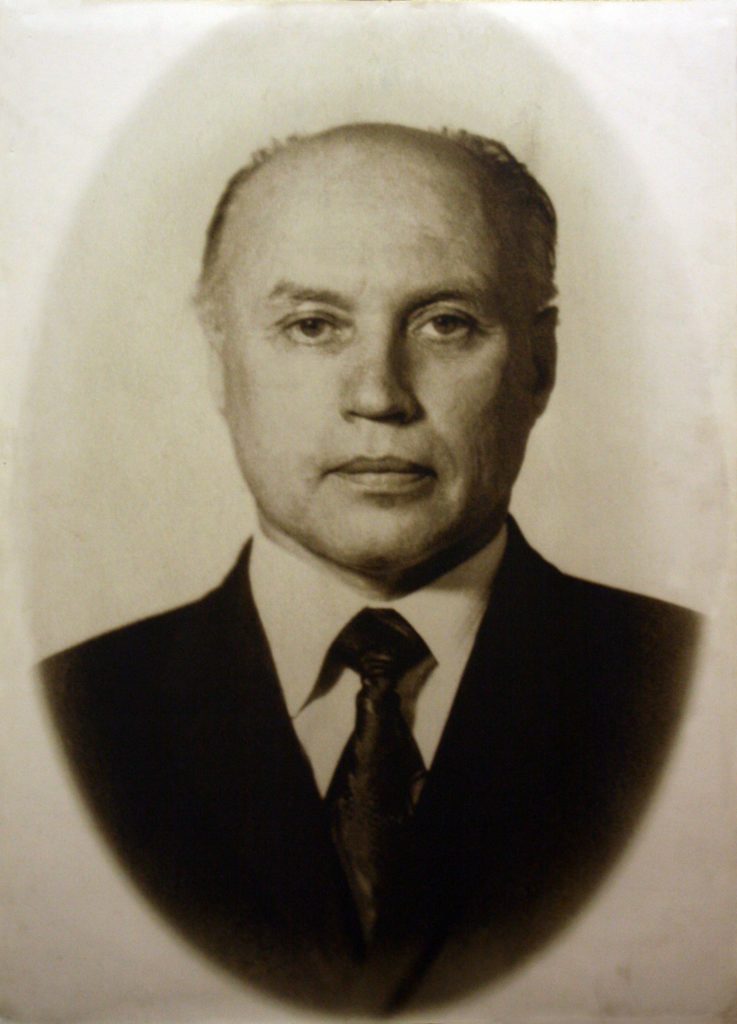
Anatoly Kitov. Copyright Vladimir Kitov
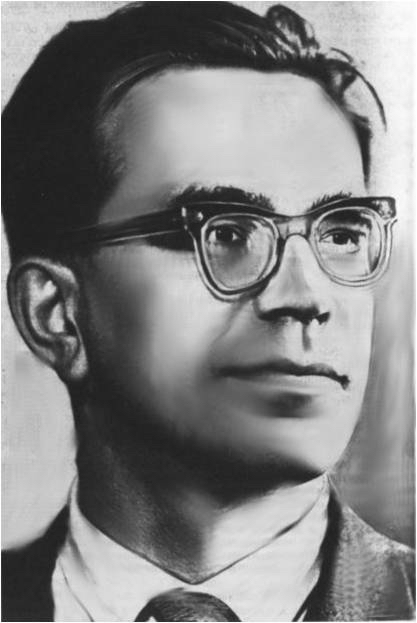
Victor Gluskov. Copyright Olga Kitova